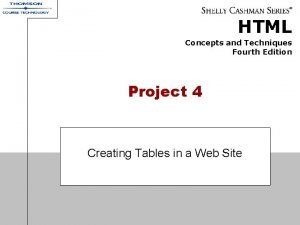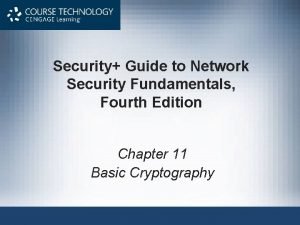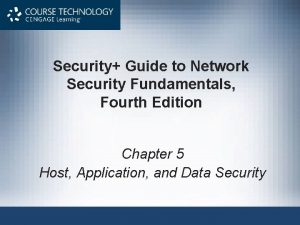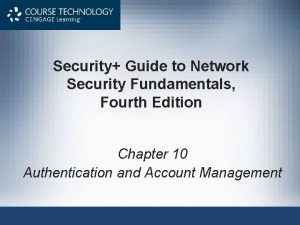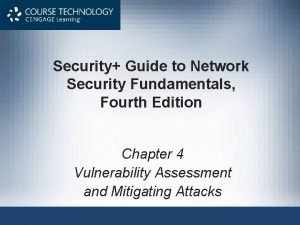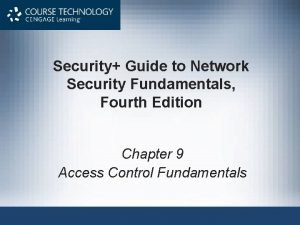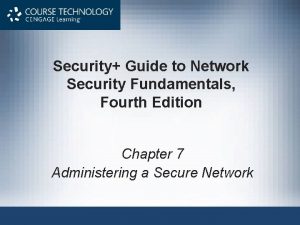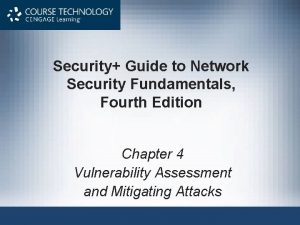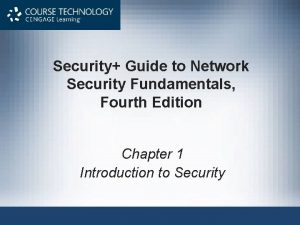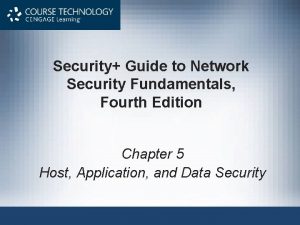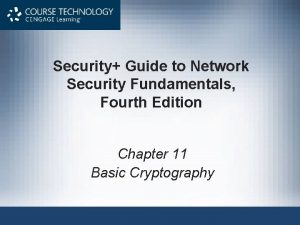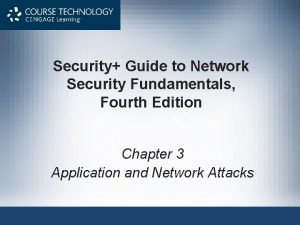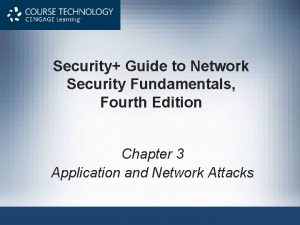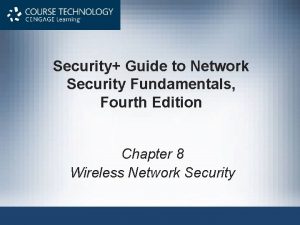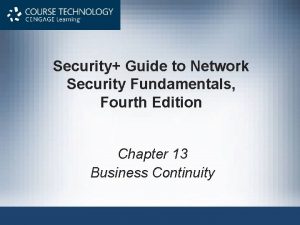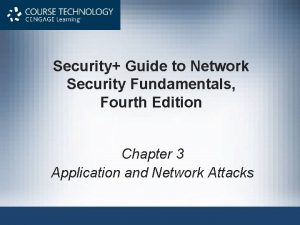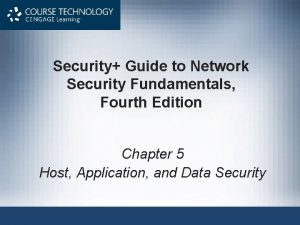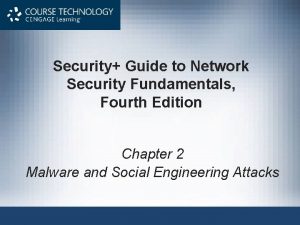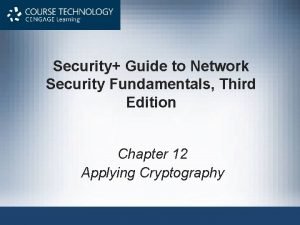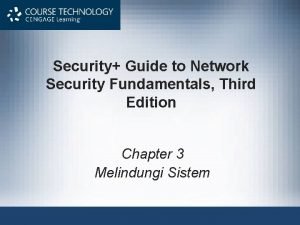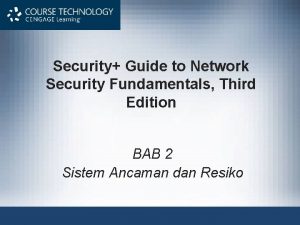Security Guide to Network Security Fundamentals Fourth Edition









































- Slides: 41

Security+ Guide to Network Security Fundamentals, Fourth Edition Chapter 3 Application and Network Attacks

Objectives • List and explain the different types of Web application attacks • Define client-side attacks • Explain how a buffer overflow attack works • List different types of denial of service attacks • Describe interception and poisoning attacks Security+ Guide to Network Security Fundamentals, Fourth Edition 2

Application Attacks • Attacks that target applications – – Category continues to grow Web application attacks Client-side attacks Buffer overflow attacks • Zero day attacks – Exploit previously unknown vulnerabilities – Victims have no time to prepare or defend Security+ Guide to Network Security Fundamentals, Fourth Edition 3

Web Application Attacks • Web applications an essential element of organizations today • Approach to securing Web applications – Hardening the Web server – Protecting the network Security+ Guide to Network Security Fundamentals, Fourth Edition 4

Figure 3 -1 Web application infrastructure © Cengage Learning 2012 Security+ Guide to Network Security Fundamentals, Fourth Edition 5

Web Application Attacks (cont’d. ) • Common Web application attacks – – Cross-site scripting SQL injection XML injection Command injection / directory traversal Security+ Guide to Network Security Fundamentals, Fourth Edition 6

Figure 3 -2 Web application security © Cengage Learning 2012 Security+ Guide to Network Security Fundamentals, Fourth Edition 7

Cross-Site Scripting (XSS) • Injecting scripts into a Web application server – Directs attacks at clients Figure 3 -3 XSS attacks © Cengage Learning 2012 Security+ Guide to Network Security Fundamentals, Fourth Edition 8

Cross-Site Scripting (cont’d. ) • When victim visits injected Web site: – Malicious instructions sent to victim’s browser • Browser cannot distinguish between valid code and malicious script • Requirements of the targeted Web site – Accepts user input without validation – Uses input in a response without encoding it • Some XSS attacks designed to steal information: – Retained by the browser Security+ Guide to Network Security Fundamentals, Fourth Edition 9

Figure 3 -4 Bookmark page that accepts user input without validating and provides unencoded response © Cengage Learning 2012 Security+ Guide to Network Security Fundamentals, Fourth Edition 10

Figure 3 -5 Input used as response © Cengage Learning 2012 Security+ Guide to Network Security Fundamentals, Fourth Edition 11

SQL Injection • Targets SQL servers by injecting commands • SQL (Structured Query Language) – Used to manipulate data stored in relational database • Forgotten password example – Attacker enters incorrectly formatted e-mail address – Response lets attacker know whether input is being validated Security+ Guide to Network Security Fundamentals, Fourth Edition 12

SQL Injection (cont’d. ) • Forgotten password example (cont’d. ) – Attacker enters email field in SQL statement – Statement processed by the database – Example statement: SELECT fieldlist FROM table WHERE field = ‘whatever’ or ‘a’=‘a’ – Result: All user email addresses will be displayed Security+ Guide to Network Security Fundamentals, Fourth Edition 13

SQL Injection (cont’d. ) Table 3 -1 SQL injection statements • See link Ch 3 f Security+ Guide to Network Security Fundamentals, Fourth Edition 14

XML Injection • Markup language – Method for adding annotations to text • HTML – Uses tags surrounded by brackets – Instructs browser to display text in specific format • XML – Carries data instead of indicating how to display it – No predefined set of tags • Users define their own tags Security+ Guide to Network Security Fundamentals, Fourth Edition 15

XML Injection (cont’d. ) • XML attack – Similar to SQL injection attack – Attacker discovers Web site that does not filter user data – Injects XML tags and data into the database • Xpath injection – Specific type of XML injection attack – Attempts to exploit XML Path Language queries Security+ Guide to Network Security Fundamentals, Fourth Edition 16

Command Injection / Directory Traversal • Web server users typically restricted to root directory • Users may be able to access subdirectories: – But not parallel or higher level directories • Sensitive files to protect from unauthorized user access – Cmd. exe can be used to enter text-based commands – Passwd (Linux) contains user account information Security+ Guide to Network Security Fundamentals, Fourth Edition 17

Command Injection / Directory Traversal (cont’d. ) • Directory traversal attack – Takes advantage of software vulnerability – Attacker moves from root directory to restricted directories • Command injection attack – Attacker enters commands to execute on a server Security+ Guide to Network Security Fundamentals, Fourth Edition 18

Client-Side Attacks • Web application attacks are server-side attacks • Client-side attacks target vulnerabilities in client applications – Interacting with a compromised server – Client initiates connection with server, which could result in an attack Security+ Guide to Network Security Fundamentals, Fourth Edition 19

Client-Side Attacks (cont’d. ) • Drive-by download – Client computer compromised simply by viewing a Web page – Attackers inject content into vulnerable Web server • Gain access to server’s operating system – Attackers craft a zero pixel frame to avoid visual detection – Embed an HTML document inside main document – Client’s browser downloads malicious script – Instructs computer to download malware Security+ Guide to Network Security Fundamentals, Fourth Edition 20

Client-Side Attacks (cont’d. ) • Header manipulation – HTTP header contains fields that characterize data being transmitted – Headers can originate from a Web browser • Browsers do not normally allow this • Attacker’s short program can allow modification • Examples of header manipulation – Referer – Accept-language Security+ Guide to Network Security Fundamentals, Fourth Edition 21

Client-Side Attacks (cont’d. ) • Referer field indicates site that generated the Web page – Attacker can modify this field to hide fact it came from another site – Modified Web page hosted from attacker’s computer • Accept-language – Some Web applications pass contents of this field directly to database – Attacker could inject SQL command by modifying this header Security+ Guide to Network Security Fundamentals, Fourth Edition 22

Client-Side Attacks (cont’d. ) • Cookies and Attachments – Cookies store user-specific information on user’s local computer • Web sites use cookies to identify repeat visitors • Examples of information stored in a cookie – Travel Web sites may store user’s travel itinerary – Personal information provided when visiting a site • Only the Web site that created a cookie can read it Security+ Guide to Network Security Fundamentals, Fourth Edition 23

Client-Side Attacks (cont’d. ) • First-party cookie – Cookie created by Web site user is currently visiting • Third-party cookie – Site advertisers place a cookie to record user preferences • Session cookie – Stored in RAM and expires when browser is closed Security+ Guide to Network Security Fundamentals, Fourth Edition 24

Client-Side Attacks (cont’d. ) • Persistent cookie – Recorded on computer’s hard drive – Does not expire when browser closes • Secure cookie – Used only when browser visits server over secure connection – Always encrypted Security+ Guide to Network Security Fundamentals, Fourth Edition 25

Client-Side Attacks (cont’d. ) • Flash cookie – Uses more memory than traditional cookie – Cannot be deleted through browser configuration settings – See Project 3 -6 to change Flash cookie settings • Cookies pose security and privacy risks – May be stolen and used to impersonate user – Used to tailor advertising – Can be exploited by attackers Security+ Guide to Network Security Fundamentals, Fourth Edition 26

Client-Side Attacks (cont’d. ) • Session hijacking – Attacker attempts to impersonate user by stealing or guessing session token • Malicious add-ons – Browser extensions provide multimedia or interactive Web content – Active X add-ons have several security concerns Security+ Guide to Network Security Fundamentals, Fourth Edition 27

Figure 3 -7 Session hijacking © Cengage Learning 2012 Security+ Guide to Network Security Fundamentals, Fourth Edition 28

Client-Side Attacks (cont’d. ) • Buffer overflow attacks – Process attempts to store data in RAM beyond boundaries of fixed-length storage buffer – Data overflows into adjacent memory locations – May cause computer to stop functioning – Attacker can change “return address” • Redirects to memory address containing malware code Security+ Guide to Network Security Fundamentals, Fourth Edition 29

Figure 3 -8 Buffer overflow attack © Cengage Learning 2012 Security+ Guide to Network Security Fundamentals, Fourth Edition 30

Network Attacks • Denial of service (Do. S) – Attempts to prevent system from performing normal functions – Ping flood attack • Ping utility used to send large number of echo request messages • Overwhelms Web server – Smurf attack • Ping request with originating address changed • Appears as if target computer is asking for response from all computers on the network Security+ Guide to Network Security Fundamentals, Fourth Edition 31

Network Attacks • Denial of service (Do. S) (cont’d. ) – SYN flood attack • Takes advantage of procedures for establishing a connection • Distributed denial of service (DDo. S) – Attacker uses many zombie computers in a botnet to flood a device with requests – Virtually impossible to identify and block source of attack Security+ Guide to Network Security Fundamentals, Fourth Edition 32

Figure 3 -9 SYN flood attack © Cengage Learning 2012 Security+ Guide to Network Security Fundamentals, Fourth Edition 33

Interception • Man-in-the-middle – – Interception of legitimate communication Forging a fictitious response to the sender Passive attack records transmitted data Active attack alters contents of transmission before sending to recipient • Replay attacks – Similar to passive man-in-the-middle attack Security+ Guide to Network Security Fundamentals, Fourth Edition 34

Interception (cont’d. ) • Replay attacks (cont’d. ) – Attacker makes copy of transmission • Uses copy at a later time – Example: capturing logon credentials • More sophisticated replay attacks – Attacker captures network device’s message to server – Later sends original, valid message to server – Establishes trust relationship between attacker and server Security+ Guide to Network Security Fundamentals, Fourth Edition 35

Poisoning • ARP poisoning – Attacker modifies MAC address in ARP cache to point to different computer Table 3 -3 ARP poisoning attack Security+ Guide to Network Security Fundamentals, Fourth Edition 36

Poisoning (cont’d. ) Table 3 -4 Attacks from ARP poisoning Security+ Guide to Network Security Fundamentals, Fourth Edition 37

Poisoning (cont’d. ) • DNS poisoning – Domain Name System is current basis for name resolution to IP address – DNS poisoning substitutes DNS addresses to redirect computer to another device • Two locations for DNS poisoning – Local host table – External DNS server Security+ Guide to Network Security Fundamentals, Fourth Edition 38

Figure 3 -12 DNS poisoning © Cengage Learning 2012 Security+ Guide to Network Security Fundamentals, Fourth Edition 39

Attacks on Access Rights • Privilege escalation – Exploiting software vulnerability to gain access to restricted data – Lower privilege user accesses functions restricted to higher privilege users – User with restricted privilege accesses different restricted privilege of a similar user Security+ Guide to Network Security Fundamentals, Fourth Edition 40

Attacks on Access Rights (cont’d. ) • Transitive access – Attack involving a third party to gain access rights – Has to do with whose credentials should be used when accessing services • Different users have different access rights Security+ Guide to Network Security Fundamentals, Fourth Edition 41
 Security guide to network security fundamentals
Security guide to network security fundamentals Security guide to network security fundamentals
Security guide to network security fundamentals Security guide to network security fundamentals
Security guide to network security fundamentals Computer security fundamentals 4th edition
Computer security fundamentals 4th edition Project 2 fourth edition
Project 2 fourth edition Algebra 2 module 1 answer key
Algebra 2 module 1 answer key Ethics in information technology fourth edition
Ethics in information technology fourth edition Ethics in information technology 6th edition answers
Ethics in information technology 6th edition answers Vertical line html
Vertical line html Discrete mathematics with applications fourth edition
Discrete mathematics with applications fourth edition Expert systems: principles and programming, fourth edition
Expert systems: principles and programming, fourth edition William stallings network security essentials 5th edition
William stallings network security essentials 5th edition Cryptography and network security 6th edition
Cryptography and network security 6th edition Cryptography and network security 6th edition pdf
Cryptography and network security 6th edition pdf Cryptography and network security 4th edition
Cryptography and network security 4th edition Network security essentials 5th edition
Network security essentials 5th edition Pearson cryptography and network security
Pearson cryptography and network security Fundamentals of information systems 9th edition
Fundamentals of information systems 9th edition Fundamentals of information systems 9th edition
Fundamentals of information systems 9th edition Fluid mechanics fundamentals and applications 3rd edition
Fluid mechanics fundamentals and applications 3rd edition Floyd digital fundamentals
Floyd digital fundamentals Machining fundamentals 10th edition
Machining fundamentals 10th edition Fundamentals of organizational communication 9th edition
Fundamentals of organizational communication 9th edition Fundamentals of organizational communication 9th edition
Fundamentals of organizational communication 9th edition Fundamentals of corporate finance, third canadian edition
Fundamentals of corporate finance, third canadian edition Floyd digital fundamentals ppt
Floyd digital fundamentals ppt Floyd digital fundamentals 10th edition pdf
Floyd digital fundamentals 10th edition pdf Dc/ac fundamentals 1st edition
Dc/ac fundamentals 1st edition Management fundamentals 8th edition
Management fundamentals 8th edition Fundamentals of information systems 9th edition
Fundamentals of information systems 9th edition Fundamentals of corporate finance canadian edition
Fundamentals of corporate finance canadian edition Fundamentals of corporate finance fifth edition
Fundamentals of corporate finance fifth edition Corporate finance 6th edition
Corporate finance 6th edition Fundamentals of abnormal psychology ninth edition
Fundamentals of abnormal psychology ninth edition Fundamentals of information systems 9th edition
Fundamentals of information systems 9th edition Fundamentals of heat and mass transfer 4th edition
Fundamentals of heat and mass transfer 4th edition The fundamentals of political science research 2nd edition
The fundamentals of political science research 2nd edition Osi security model
Osi security model Wireless security in cryptography
Wireless security in cryptography Electronic mail security in network security
Electronic mail security in network security Using mis 10th edition
Using mis 10th edition Using mis (10th edition)
Using mis (10th edition)








